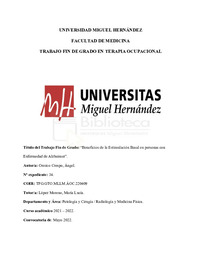Resumen :
El informe realizado se centra en la intervención en un caso clínico, en el cual la usuaria con la que
trabajamos presenta un GDS 6 de Enfermedad de Alzheimer (EA), la usuaria no presenta
comunicación verbal ni no verbal, además, la persona presenta un alto nivel de hipersensibilidad
el cual hemos podido apreciar al pasar la escala de evaluación perfil sensorial en adultos. La intervención se va a centrar en la técnica de Estimulación Basal (EB), el cual busca potenciar
la comunicación y el entendimiento, además de, acercar a la persona al mundo y a su entorno para
conseguir que esta vida con la mayor calidad posible. Esta técnica tiene una importante implicación
en este tipo de personas, puesto que, a partir de unas sencillas actividades podemos conseguir
mantener más activos y conectados con el mundo a la persona con EA. Hay que añadir que en la intervención buscamos trabajar para que sean los familiares las personas
que lleven a cabo la intervención más cercana con sus familiares y de este modo mejorar la
interacción en comunicación no verbal entre la familia y la persona con EA.
Por ultimo, la intervención busca trabajar con los familiares ya que en muchas ocasiones presenta
el síndrome del cuidador quemado, puesto que, es algo muy común en la EA ya que es una
patología de duración muy larga y de mucho desgaste para los familiares. La EB va a ayudar a los
familiares a mejorar la comunicación con su familiar con EA y de este modo reducir o frenar el
síndrome del cuidador quemado.
The report focuses on the intervention in a clinical case, in which the user with whom we work
presents a GDS 6 of Alzheimer's Disease (AD), the user does not present verbal or non-verbal
communication, in addition, the person presents a high level of hypersensitivity which we have
been able to appreciate by passing the sensory profile assessment scale in adults.
The intervention will focus on the technique of Basal Stimulation (BS), which seeks to enhance
communication and understanding, as well as to bring the person closer to the world and their
environment in order to achieve the best possible quality of life. This technique has an important
implication in this type of people, since, from a few simple activities we can keep the person with
AD more active and connected with the world. It should be added that in the intervention we try to work so that the family members are the ones
who carry out the closest intervention with their relatives and in this way improve the interaction
in non-verbal communication between the family and the person with AD.
Finally, the intervention seeks to work with the relatives, as they often present burnt-out caregiver
syndrome, which is very common in AD, as it is a pathology with a very long duration and a lot of
wear and tear for the relatives. EB will help family members to improve communication with their
family member with AD and thus reduce or stop burnt-out caregiver syndrome.
|

 La licencia se describe como: Atribución-NonComercial-NoDerivada 4.0 Internacional.
La licencia se describe como: Atribución-NonComercial-NoDerivada 4.0 Internacional.
.png)